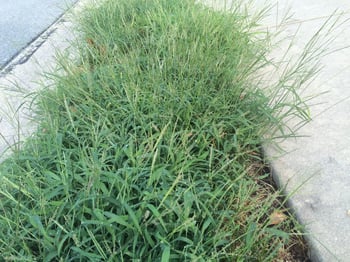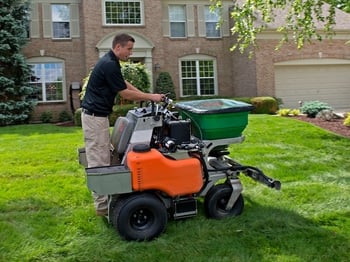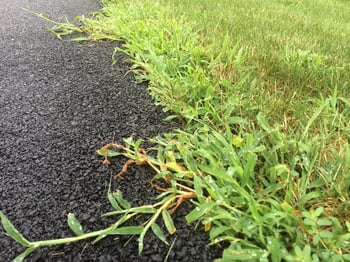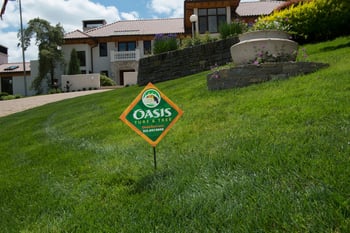 Crabgrass is the pesky nemesis of your otherwise beautifully manicured lawn. It’s one of those weeds that is difficult to get rid of and can spread like wildfire.
Crabgrass is the pesky nemesis of your otherwise beautifully manicured lawn. It’s one of those weeds that is difficult to get rid of and can spread like wildfire.
So how does crabgrass grow and spread? Well, just a single plant can produce up to 75,000 seeds which lay dormant in the soil until the ideal timing for germination in late spring. As the weed continues to spread throughout the summer, it begins to crowd out your turf in large, dense mats across your lawn.
Crabgrass takes very little nurturing to grow and thrive and therefore can begin to choke out your desired turfgrasses in only a short amount of time. Crabgrass also likes heat and will often pop up heavily in thin areas of your lawn or alongside your driveway and walkways. These conditions are typically areas where your lawn will struggle during summer, so this contributes to even more crabgrass.
Fortunately, it doesn’t have to be that way. The right crabgrass control strategy will ensure this nemesis doesn’t wreak havoc on your healthy lawn.
How Does Crabgrass Preventer Work
By applying crabgrass preventer in the form of granular material to the entire lawn, it will dissolve and form a thin barrier near the surface of the soil which intercepts the germinating crabgrass seeds. When the germinating seed comes into contact with the product, it stops growing. This prevents the majority of crabgrass from growing in the first place.
While it will prevent the majority of crabgrass growth (80 to 85 percent), it’s not foolproof. Breaks in the barrier such as those caused by mowing/trimming, digging, dryness or cracking, or excessive rainfall can lead to breakthrough crabgrass growth. That’s why it’s important to stay on top of trouble spots in your lawn.
When to Apply Crabgrass Preventer
 While you may have heard that the best time to apply a crabgrass control product is “when the forsythia is in bloom,” that’s largely due to the fact that older formulations only had small application windows. These days, the latest formulations allow for a slightly larger application window.
While you may have heard that the best time to apply a crabgrass control product is “when the forsythia is in bloom,” that’s largely due to the fact that older formulations only had small application windows. These days, the latest formulations allow for a slightly larger application window.
Still, in order for the product to work properly, it does need to be applied in the spring. At Oasis, we get the first application down before April 20th and will then return for a second application in order to reinforce that barrier and build on top of it. The amount of crabgrass preventer that ultimately goes down does affect how well the product will perform and it’s important to get that amount just right.
It’s also important to note that although some types of pre-emergent crabgrass control products are available in big box stores and can be purchased by homeowners, that not all products are created equally. Homeowners will not have access to the premium professional crabgrass control products that will work the best.
Summer Crabgrass Control
 While crabgrass preventer will prevent about 80 to 85 percent of crabgrass from ever growing in the first place, breakthrough growth can occur. Edges and thinner spots are more prone to breakthrough than thicker lawn areas.
While crabgrass preventer will prevent about 80 to 85 percent of crabgrass from ever growing in the first place, breakthrough growth can occur. Edges and thinner spots are more prone to breakthrough than thicker lawn areas.
A lot of lawn care companies in and around Cincinnati, Oh charge extra for spot-treating breakthrough crabgrass. However, Oasis utilizes post-emergent crabgrass control treatments throughout summer as part of our overall program. Not only do we take the most proactive approach to utilizing crabgrass preventer, but we also stick with you all season to ensure that breakthrough crabgrass is dealt with as well.
Reducing Crabgrass
There’s no question that you want to do whatever you can to reduce the crabgrass in your lawn. In addition to crabgrass preventer products, there are a few things you can do on your own to help keep crabgrass at bay.
- Mow your lawn at 3.5 inches height or higher
- Water your lawn in the summer to keep turf from weakening and thinning
- Don’t scalp the edges of your walkways or driveways when trimming
- Aerate and seed thinner lawn areas in the fall to fill them in with grass
But most importantly, you should be working closely with your professional lawn care provider in order to have the best results.
With Oasis Turf & Tree, Crabgrass Doesn’t Stand a Chance
 At Oasis Turf & Tree, we go above and beyond when it comes to crabgrass control, just as we do in the other areas of our lawn care program. In fact, our overall approach to lawn care has a big impact on preventing crabgrass in the first place.
At Oasis Turf & Tree, we go above and beyond when it comes to crabgrass control, just as we do in the other areas of our lawn care program. In fact, our overall approach to lawn care has a big impact on preventing crabgrass in the first place.
Because we focus on soil health and truly care about getting your lawn in the best shape possible, crabgrass growth will be stunted. A thick, healthy lawn is the best defense against crabgrass growth.
Between our focus on soil health, our proactive approach utilizing crabgrass preventer, and our ongoing eye on your lawn for breakthrough with necessary spot-treatments in the summer, crabgrass really doesn’t stand a chance to survive in an Oasis lawn.
If you’re looking to get crabgrass under control in your Cincinnati, Dayton, OH or Northern Kentucky lawn, be sure to contact us or give us a call at 513-697-9090.
